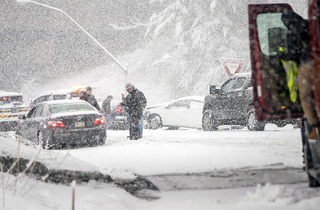Storm-related deaths occurred from diverse causes, including car accidents, falling branches, electrocutions, and carbon monoxide poisoning.
In Oklahoma, dangerous road conditions caused by the storm caused multiple accidents, killing one person.
In Kentucky, three people died; two died as a result of car accidents, while the other was “housing insecure”.
In northern Frederick County, Maryland, a man died after a tree fell on his car while he was driving west on MD 77.
In Ohio, an accident involving more than 50 vehicles on the eastbound lanes of the Ohio Turnpike in Sandusky County closed the highway for multiple hours and caused four fatalities.
The intense blizzard in the Buffalo region of New York caused 34 deaths, many of them pedestrians who had become disoriented and were found in snowbanks, as well as drivers stranded in their cars for over two days, shovellers who died from cardiac arrest, and residents who died when emergency crews could not respond in time of medical crisis.
The winter storm has also caused the cancellation of more than 10,000 flights, including about 4,800 on Tuesday morning alone.
Thousands of passengers have been left stranded at airports across the country.
United States President Joe Biden approved an emergency declaration allowing federal support for New York State.
“I spoke with Governor Kathy Hochul to get an update on the extreme winter weather hitting New York. We stand ready to make sure they have the resources they need to get through this,” Biden wrote on Twitter.
“My heart is with those who lost loved ones this holiday weekend. You are in my and Jill’s prayers,” he added.
This Storm was even deadlier than the Blizzard of 1977 for the region. (ILKHA)



 Dünya
Dünya
 Güncel
Güncel
 Güncel
Güncel
 Güncel
Güncel
 Güncel
Güncel
 Güncel
Güncel
 Dünya
Dünya
 Dünya
Dünya
 Güncel
Güncel
 Dünya
Dünya





